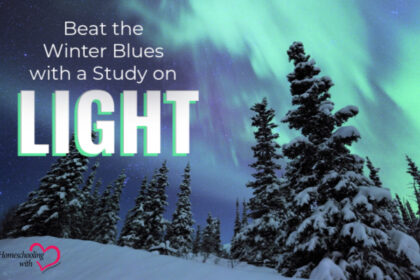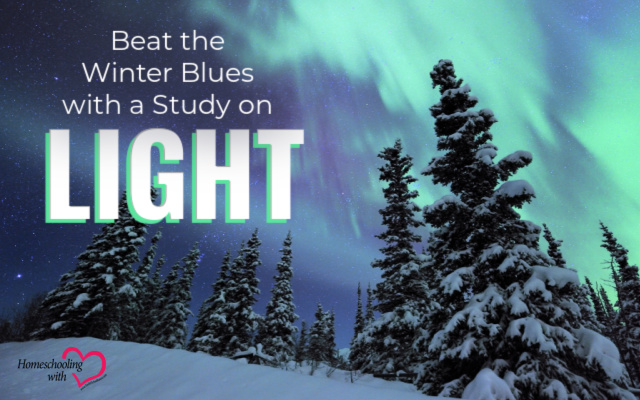Beat the Winter Blues with a Study on Light

Share this post:

At this time of the year, there is less daylight and more darkness in the northern hemisphere. To remind us that the days are getting longer again with more light and that Jesus is the Light of the world, here are a few ways to incorporate the study of light, for all ages, into your homeschool.
Science – Find and do experiments that show how light works, how light is reflected, how light helps green leaves and plants grow, etc. Study information on how electricity is made, how fire is started, or how light is reflected. Strictly speaking, the Morse code is not connected to light generation, but you may find it fun to send messages by reflecting light. You can select experiments that meet the age and skill level of your children so that it would be an enjoyable time of exploring and learning about light. You could also try making candles (If you do make candles, make sure to follow instructions given.) and then using candles as your primary source of light in the evening after it is dark outside. SchoolhouseTeachers.com has an experiment on light.
Math – Study and show how math can be used to measure brightness of light in lumens or how electricity is measured. There are different speeds, measurements, and equations for calculating light and electricity. For instance, an electrician needs to have an understanding of both math as well as how electricity works in order to properly and safely install electrical wires.
Geography – Learn about countries, cities, rivers, lakes, and other places by learning where scientists and inventors were born and where they lived when they made their discoveries and inventions.
History – Research the time in history when certain discoveries, theories, and inventions were first made. You can expand this to include looking up what other events were going on at the same time – either the same decade or century – in history.
Art – Look up paintings, drawings, and other artworks that show the use of light and shadow. Notice how the artist uses light and shadow, color and black and white throughout the composition to draw the viewer’s eye to the focal point. Have your child create an art piece of their own where light and shadow areas are included. Everyday Easels from SchoolhouseTeachers.com might be a course for your family to try.
Language Arts – Have your child write an essay, story, or poem about light. The topic could be about an inventor or scientist, a review on a book about the life of an inventor or scientist, the pros and cons of electricity compared to candles, or the period of fireplaces and torches to bring warmth and light to human dwellings. You can also include a list of spelling words to use in the essay or to look up the spelling and meaning of the words.
Literature – Read about scientists and explorers who invented and developed things – like the light bulb, electricity, and flashlight – such as Thomas Edison and Benjamin Franklin. You can read books aloud together during family story time or children can read books during quiet time. After reading, ask questions about what was read and talk about ways that you and your family use light such as to read a book, play games with family, and help with making meals or doing chores around the home.
Bible – Read and learn what the Bible says about the creation of the sun and moon and stars, day and night, light and darkness in the world, and Jesus as the Light of the world.
You can do a unit study focusing on light, take a field trip to the science center, or visit the library for more information and books. Another idea might be to get together with other homeschoolers to learn more about light. Include discussions about light throughout learning and ask questions such as how does sunlight result in the changes in seasons.
For children in junior high or high school, they might like to learn more about careers or jobs that are in science and include the study of light. Looking up the requirements to apply to science programs at post-secondary could help them begin now in deciding what science courses to take and study in high school. Another way to show junior high or high school students about electricity and light in everyday life is to introduce them to the cost of electricity from the utility bill.
Light is an important part of our world. Our days are divided into day and night. We turn on a switch, and we have electricity that immediately turns on light in a lightbulb, giving light to an area. We are blessed with day and night from the One who has created all things – light and dark – in this world. Make the study of and learning about light a fun time of learning for your children and in your homeschool.
 Barbori enjoys writing and is blessed to be part of The Old Schoolhouse team. She is the author of Home at the Office: Working Remotely as a Way of Life. You can check out her writing, books, and blog at BarboriGarnet.com.
Barbori enjoys writing and is blessed to be part of The Old Schoolhouse team. She is the author of Home at the Office: Working Remotely as a Way of Life. You can check out her writing, books, and blog at BarboriGarnet.com.













































